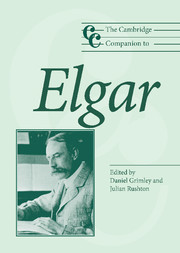Book contents
- Frontmatter
- 1 Introduction
- 2 Elgar and his British contemporaries
- 3 Elgar and his publishers
- 4 Magic by mosaic: some aspects of Elgar's compositional methods
- 5 Elgar's musical language: the shorter instrumental works
- 6 The early choral works
- 7 Elgar's later oratorios: Roman Catholicism, decadence and the Wagnerian dialectic of shame and grace
- 8 Roman Catholicism and being musically English: Elgar's church and organ music
- 9 ‘A smiling with a sigh’: the chamber music and works for strings
- 10 In search of the symphony: orchestral music to 1908
- 11 The later orchestral music (1910–34)
- 12 Elgar's unwumbling: the theatre music
- 13 Elgar and recording
- 14 Broadcasting's ally: Elgar and the BBC
- 15 Elgar in German criticism
- 16 Functional music: imperialism, the Great War, and Elgar as popular composer
- Notes
- Select bibliography
- Index
1 - Introduction
Published online by Cambridge University Press: 28 September 2011
- Frontmatter
- 1 Introduction
- 2 Elgar and his British contemporaries
- 3 Elgar and his publishers
- 4 Magic by mosaic: some aspects of Elgar's compositional methods
- 5 Elgar's musical language: the shorter instrumental works
- 6 The early choral works
- 7 Elgar's later oratorios: Roman Catholicism, decadence and the Wagnerian dialectic of shame and grace
- 8 Roman Catholicism and being musically English: Elgar's church and organ music
- 9 ‘A smiling with a sigh’: the chamber music and works for strings
- 10 In search of the symphony: orchestral music to 1908
- 11 The later orchestral music (1910–34)
- 12 Elgar's unwumbling: the theatre music
- 13 Elgar and recording
- 14 Broadcasting's ally: Elgar and the BBC
- 15 Elgar in German criticism
- 16 Functional music: imperialism, the Great War, and Elgar as popular composer
- Notes
- Select bibliography
- Index
Summary
International interest in Elgar's music has enjoyed a general revival following the performance and recordings of his Third Symphony, properly entitled ‘the sketches for Symphony No. 3 elaborated by Anthony Payne’. When permission was granted by the family for Payne to make his work public, understanding and perception of Elgar was permanently altered. Hitherto it was assumed that the death of Alice Elgar in 1920 had suppressed his creative urge, a view supported by the relatively small-scale works of his last decade, and their dependence on earlier sketches. It appears, however, that he was sufficiently restored not only to contemplate an opera (The Spanish Lady) and a new symphony, but to reach a stage in composing the latter from which a complete score could be elaborated – obviously not identical to what Elgar would have written, but rich in ideas and deeply moving in performance. And if both symphony and opera depended in part on earlier sketches, research into Elgar's compositional methods shows that to be true of many, if not all, his greatest works (see chapters 4 and 5).
In fact the level of interest in Elgar among musicians, including musical scholars, was already high. Elgar has never been long out of public view, at least in Britain, where his music is a fixture at the Last Night of the Proms. The Jacqueline du Pré phenomenon, in which a young artist working with a senior conductor (Sir John Barbirolli) presented the cello concerto unforgettably, seemed to recreate the history of Elgar recording his violin concerto with the young Yehudi Menuhin; but we should not forget that the concerto was in the repertoire of senior cellists such as Paul Tortelier. One of the most encouraging features of recent years has been the interest taken in Elgar by conductors, scholars, and audiences from, for example, Russia, Germany, Japan, and the United States.
- Type
- Chapter
- Information
- The Cambridge Companion to Elgar , pp. 1 - 14Publisher: Cambridge University PressPrint publication year: 2005



